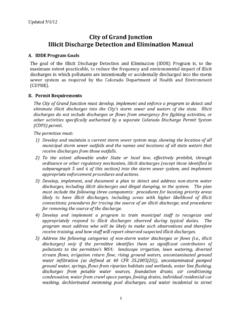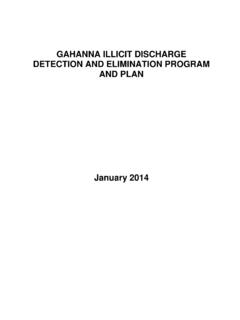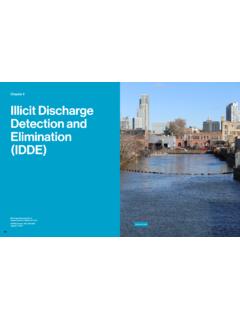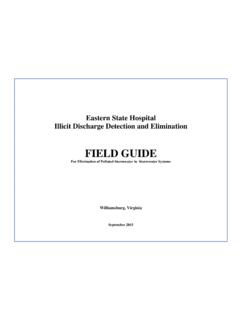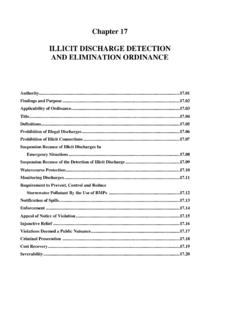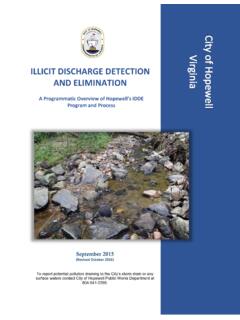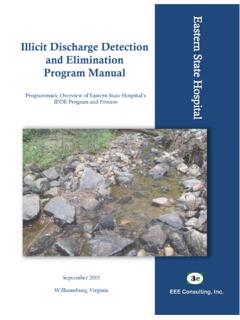Transcription of Hanover Township MS4 Program
1 September 12, 2016 Hanover Township MS4 Program illicit discharge detection and Elimination Program NPDES Permit No: PAG132231 Hanover Township Hanover Township , PA, 18706 Prepared for: Hanover Township 1267 Sans Souci Parkway Hanover Township , PA 18706 Project Number: 2016-2215-023 TABLE OF CONTENTS I. INTRODUCTION .. 1 II. BACKGROUND .. 1 III. IDD&E PRINCIPLES .. 4 IV. IDD&E PURPOSE AND GOALS .. 6 V. CURRENT IDD&E Program .. 6 VI. PROCEDURES FOR Program ASSESSMENT AND EVALUATION .. 15 VII. Hanover Township STORM SEWER MAPPING .. 16 APPENDICES APPENDIX A: STORMWATER MANAGEMENT ORDINANCE APPENDIX B: Hanover Township MUNICIPAL STORM SEWERS MAP APPENDIX C: 2016-2018 FIELD MONITORING SCHEDULE APPENDIX D: OUTFALL RECONNISSANCE INVENTORY/SAMPLE COLLECTION FIELD SHEET APPENDIX E: ADDITIONAL IDD&E REPORTING FORMS 1 I.
2 INTRODUCTION According to the Environmental Protection Agency (EPA) a Municipal Separate Storm Sewer (MS4) is a conveyance or system of conveyances that is: Owned by a state, city, town, village, or other public entity that discharges to waters of the ; Designed or used to collect or convey stormwater (including storm drains, pipes, ditches, etc.); Not a combined sewer; and Not part of a Publicly Owned Treatment Works (sewage treatment plant) MS4 are collection systems designed to move stormwater, including rainwater and snow melt, through a conveyance system (drains, pipes, ditches, and open channels) to waterways. As stormwater collects in MS4, contamination is a possibility. For example, if stormwater were to flow through agricultural lands before discharging to an MS4, it may pick up pesticides, fertilizers, and/or sediments.
3 Other sources of stormwater contamination include oil and grease from roadways, discarded trash, and household hazardous waste, like solvents and motor oil. Since stormwater is not treated, any pollutants carried in stormwater will end up into the conveyance system and ultimately in waterways, potentially threatening public health (contaminated food, drinking water, and recreational waterways), harming freshwater ecosystems, and degrading the aesthetic value of waterways. Municipalities in urbanized areas (UAs) must obtain NPDES permit coverage and develop a stormwater management Program to discharge stormwater from their MS4. After permit coverage approval and as a part of the stormwater management Program , municipalities are required to develop and maintain an active MS4 Program that addresses requirements of the Pennsylvania Department of Environmental Protection (PA DEP), as well as the EPA.
4 These requirements include elements that address the six Minimum Control Measures (MCMs) established by the EPA: 1. Public Education and Outreach on Stormwater Impacts 2. Public Involvement/Participation 3. illicit discharge detection and Elimination 4. Construction Site Stormwater Runoff Control 5. Post-Construction Stormwater Management (PCSM) in New and Re-Development Activities 6. Pollution Prevention/Good Housekeeping for Municipal Operations The Township of Hanover is committed to continuing in the development, implementation, and enforcement of a MS4 Program that is designed to reduce the discharge of pollutants from the regulated MS4, protect water quality, and closely follow the requirements of PA DEP and the EPA. II. BACKGROUND Hanover Township , located in northeastern Pennsylvania, is a community within the Wyoming Valley, which is the region surrounding the Susquehanna River in Luzerne County.
5 T he Township is bordered on the northeast by the City of Wilkes-Barre, on the southwest by the City of Nanticoke, on the northwest by the Susquehanna River, and on the east by Penobscot Mountain. The Township is also broken out into villages, which include Askam, Breslau, Buttonwood, Hanover Green, Iona, Korn Krest, Lee Park, Lower Askam, Newtown, and Preston. The Township itself is composed of approximately square miles, which includes about square miles of water. For the sake of the MS4 Program , only the US Census Bureau-designated 2 urbanized areas are considered within the MS4 Program jurisdiction. The designated urbanized areas in Hanover Township have an approximate area of square miles. The urbanized area is located northwest of Route 81, and encloses the remaining area of the Township and where it abuts the Susquehanna River.
6 Additionally, three (3) boroughs are landlocked by the Township , including Ashley, Sugar Notch, and Warrior Run. Those areas have not been included as a part of the urbanized area or the MS4 Program jurisdiction of the Township The following presents the IDD&E Program for Hanover Township . The primary goal of the IDD&E Program is to identify illicit discharges, eliminate them, and prevent future illicit discharge through education, training, and enforcement. Unlike the Public Education and Outreach Program (PEOP) and Public Involvement/Participation Program (PIPP), the IDD&E is more focused on municipal employees as they are the ones responsible for the management of the MS4. The IDD&E involves the public through training and prevention of future illicit discharge , so therefore it does relate with practices previously established under the PEOP and PIPP.
7 The MS4 in the Township collects runoff, conveys the water through a system of pipes and swales, and then discharges it to local surface waters, which include Nanticoke Creek (CWF, MF), Solomon Creek (CWF, MF), Warrior Creek (CWF, MF), Spring Run (CWF, MF), Sugar Notch Run (CWF, MF), and the Susquehanna River (WWF, MF), all of which require management under the Township s NPDES permit. As part of the Authorization to discharge waters from the MS4 to surface waters, there are specific requirements that include illicit discharge management and involvement in water quality improvement issues. The IDD&E Program falls under the requirements of Minimum Control Measure #3 (MCM #3), which contains a series of Best Management Practices (BMPs) that must be met. The requirements for MCM #3 and the associated BMPs are as follows: MCM #3: illicit discharge detection & Elimination (IDD&E) As stated in the Federal Regulations, the following are the requirements of MCM #3: Develop, implement, and enforce a Program to detect and eliminate illicit discharges into the MS4 (40 CFR Part (b)(3)(i)).
8 Develop, if not already completed, a storm sewer system map, showing the location of all outfalls and the names and locations of all surface waters of the Commonwealth that receive discharges from those outfalls (40 CFR Part (b)(3)(ii)(A)). To the extent allowable under State or local law, effectively prohibit, through ordinance, or other regulatory mechanism, non-stormwater discharges into your storm sewer system and implement appropriate enforcement procedures and actions (40 CFR Part (b)(3)(ii)(B)). Develop and implement a plan to detect and address non-stormwater discharges, including illegal dumping, to your system (40 CFR Part (b)(3)(ii)(C)). Inform public employees, businesses, and the general public of hazards associated with illegal discharges and improper disposal of waste (40 CFR Part (b)(3)(ii)(D)).
9 Per MCM #3, Hanover Township must comply with six (6) Best Management Practices, or BMPs, in order to obtain compliance. The following presents the requirements of the BMPs: BMP #1: You shall develop and implement a written Program for the detection , elimination, and prevention of illicit discharges into your regulated MS4s. Your Program shall include dry 3 weather field screening of outfalls for non-stormwater flows, and sampling of dry weather discharges for selected chemical and biological parameters. Test results shall be used as indicators of possible discharge sources. The Program shall include the following: o Procedures for identifying priority areas. These are areas with a higher likelihood of illicit discharges, illicit connections or illegal dumping. Priority areas may include areas with older infrastructure, a concentration of high-risk activities, or past history of water pollution problems.
10 O Procedures for screening outfalls in priority areas during varying seasonal and meteorological conditions o Procedures for identifying the source of an illicit discharge when a contaminated flow is detected at a regulated small MS4 outfall. o Procedures for eliminating an illicit discharge . o Procedures for assessing the potential for illicit discharges caused by the interaction of sewage disposal systems ( , on-lot septic systems, sanitary piping) with storm drain systems. o Mechanisms for gaining access to private property to inspect outfalls ( , land easements, consent agreements, search warrants). o Procedures for Program documentation, evaluation and assessment. BMP #2: Develop and maintain a map of your regulated small MS4. The map must also show the location of all outfalls and the locations and names of all surface waters of the Commonwealth ( , creek, stream, pond, lake, basin, swale, channel) that receive discharges from those outfalls.

